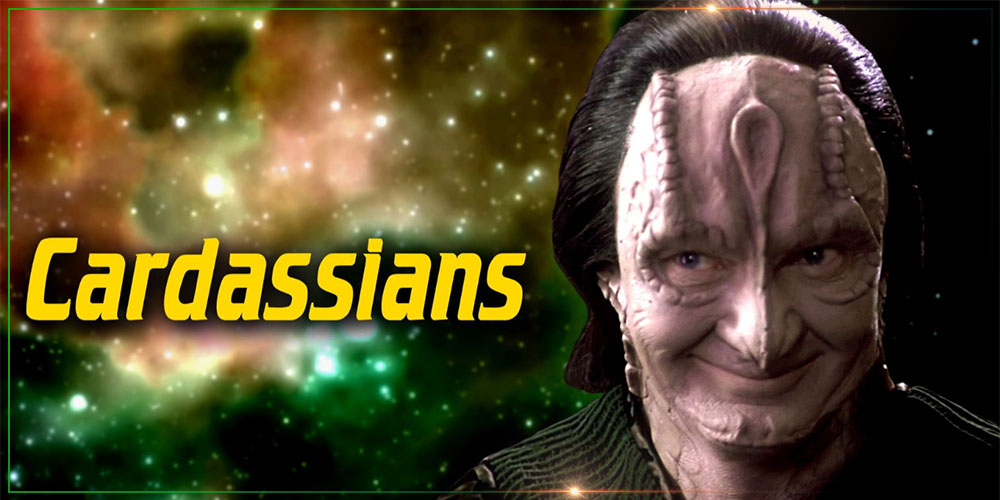Hey guys, what’s up? Tyler here. So, Star Trek as a franchise is quite interesting in its approach to depicting alien life forms: while it has its share of truly bizarre and exotic creatures, most races we see throughout Trek are humanoid in appearance. Furthermore, many of these humanoid races appear to be nothing more than humans with nose or forehead ridges. But there are several races in between—and in fact, many of the major recurring species who are given ample screen time have very creative designs. This is especially true, I think, with the Cardassians.
The Cardassians, first introduced in The Next Generation, are heavily featured in Star Trek: Deep Space Nine. Their government, the Cardassian Union, had occupied the planet Bajor for decades before the start of DS9’s run, and in their wake, they left a very messy situation—to say the least. But while their society, culture, and politics are interesting in and of themselves, today, I want to focus on their biology and answer some questions that people, including myself, have had about this unique race. This is Alien Biology: The Cardassians.
Like many other humanoid species in the galaxy, the Cardassians are said to be descended from a genetic code planted by ancient humanoid Progenitors approximately 4.5 billion years ago. They’re characterized primarily by their light-grey skin, two thick, vertical neck ridges that recede back to the crown of their head, and a roughly teardrop-shaped ridge in the centre of their forehead. Their facial ridges are the thickest right above their eyes, resulting in a deep-set appearance slightly reminiscent of the brow ridges of some of our ancient hominid cousins. Female Cardassians have generally softer ridges as well as a blue colouration on their forehead teardrop, an example of sexual dimorphism (of course, the blue colouration may likely be makeup). Cardassians generally have straight black hair that often greys with age; their blood is red in colour, presumably utilizing iron-based haemoglobin; and they also have hearing that is less acute than in humans.
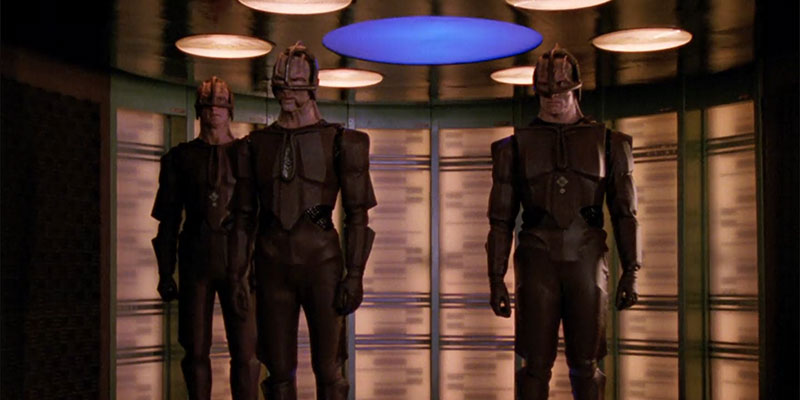
Unlike some races such as the Vulcans, the Tellarites, the Orions, or the Andorians, we don’t know exactly which real-world star in the Milky Way serves as the analogue to the Cardassians’ sun, but Star Trek: Star Charts suggests Cardassia orbits a K-type giant orange star with an absolute magnitude of -1.1, a hundred times brighter than Sol. Cardassia Prime, as the Cardassians call their homeworld, is the second planet in an eight-planet system. Of course, it should be noted that Star Charts erroneously places Cardassia Prime as the sixth planet, so the claim surrounding its star’s absolute magnitude could be called into question.
Because of its relative closeness to its star and the Cardassian sun’s relative brightness, it’s no wonder that the Cardassians enjoy warmer temperatures compared to other species. As I mentioned in my Alien Biology video about the Asari from Mass Effect, a planet around a star that outputs redder wavelengths than our sun would likely have vegetation that is darker and browner in colour, and in fact, Cardassia Prime delivers on this. Images of Cardassia Prime show vegetation that is indeed darker and browner, though admittedly with a slight green tinge. This contributes to a “swampy” atmosphere and aesthetic when viewing the planet from space, and of course, on the surface, this brown palette is present in their architecture while their sky is bright red-orange.
What does all this have to do with Cardassian physiology? Well, as you can imagine, a species’ environment is heavily influential on its biology. It’s one of the foundational principles of Darwinian evolution. We are told in various episodes of Deep Space Nine that the Cardassians do prefer darker, hotter, and more humid environments than humans, which has contributed to one of the biggest topics of debate surrounding the Cardassians in my experience: are the Cardassians mammals or reptiles? The short answer is, “no” to both. While many species in Star Trek are recognizably mammalian, reptilian, amphibious, et cetera, the truth is, not every species in every world will evolve into those neat classifications—the Cardassians are best described as, well, aliens.
But the long answer is more complicated. The connection between Cardassians and reptiles has been noted many a time not only by fans but actors and production staff. Michael Westmore, the makeup supervisor on many of the Star Trek spinoff series, referred to Gul Ocett’s makeup as akin to a scaly “reptilian type of armour skin.” The Cardassians’ preference for warmer temperatures is also a reptilian trait, as reptiles are cold-blooded. Andrew Robinson, who played Elim Garak throughout DS9, has made several references to the Cardassians’ neuropsychology, likening their brains to the reptilian portion of mammalian brains. It’s this “reptilian brain” that gives them, in his estimation, their sense of boundaries, their strict code of justice, and their suspicious and aggressive nature. Cardassian society is organized in such a way that values law and order over freedom and equality, and consequently, their government—a military dictatorship—maintains Orwellian control over its population. It should be noted, though, that this wasn’t always the case—there are multiple references to a Cardassia that was more peaceful and democratic, when art and culture flourished before the authoritarianism, likely a response to resource shortages, began to sink in.
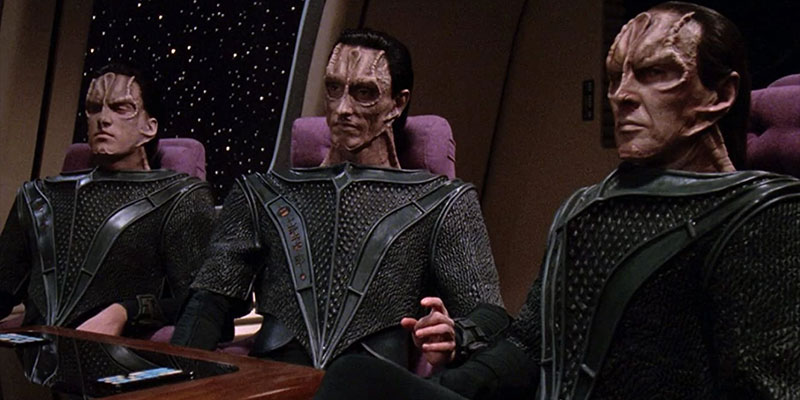
To be clear, the “reptilian brain” hypothesis regarding mammalian development is no longer considered to be valid in many scientific circles. The original hypothesis, developed in the 1960s by neuroscientist Dr Paul MacLean and popularized by Carl Sagan’s 1977 book The Dragons of Eden, is called the “triune brain hypothesis.” It describes a model of the brain with three complexes: the “reptilian complex” or basal ganglia, the “paleomammalian complex,” or the limbic system, and the “neomammalian complex,” or neocortex. The basal ganglia, situated in the forebrain, are strongly associated with voluntary motor controls, procedural and habitual learning, eye movement, cognition, and emotion. MacLean argued that these structures dominated the brains of reptiles and birds and that the “reptilian complex” was responsible for instinctual behaviours like aggression, dominance, territoriality, and ritual displays.
All this is well and good, but seemingly reptilian traits do not a reptilian species make. That said, Memory Beta—the wiki for non-canon Star Trek works such as novels, games, and comics—refers to the Cardassians as “quasi-reptilian” and includes them in the category “Reptilian races and cultures.” But while this is true, the Cardassians do possess many other features that are more associated with mammals: female Cardassians have breasts, and while Cardassians’ ridges do somewhat resemble scales, their skin overall is much more like that of humans despite the difference in colouration. Additionally, while their behaviours would seem to suggest they might be cold-blooded, it’s never explicitly stated if this is the case or if Cardassians can regulate their body temperature and simply have a different threshold for how hot or cold they can let their bodies get.
So, what’s the answer? Well, there is one theory that makes the most sense to me. According to the Decipher RPG module Aliens, Cardassians may have evolved from a creature that, like them, possesses both mammalian and reptilian traits. There are quite a few such animals throughout our own planet’s history—logically, the common ancestor of mammals and reptiles would have possessed traits of both. Early synapsids, a clade of amniote tetrapods, used to be referred to as “mammal-like reptiles,” although this terminology is now considered outdated as the understanding of mammalian diversification has changed. Technically, synapsids also include modern mammals, including humans.
The therapsids are a group of synapsids that evolved around 275 million years ago, distinct from reptiles. Therapsids include all mammals and their ancestors, which bodes well for our investigation: one of their defining traits is the orientation of limbs beneath the body as opposed to more beside the body, such as the limb configuration seen in lizards and crocodiles. Therapsids include the clade Cynodontia, which first appeared in the Late Permian period and gave rise to the mammalian lineage around 225 million years ago. There was a non-mammalian lineage of cynodonts, Tritylodontidae, that went extinct around 113 million years ago, but these creatures were defined mainly by the shape of their teeth and their herbivorous diet—traits that are explicitly not shared by the Cardassians.
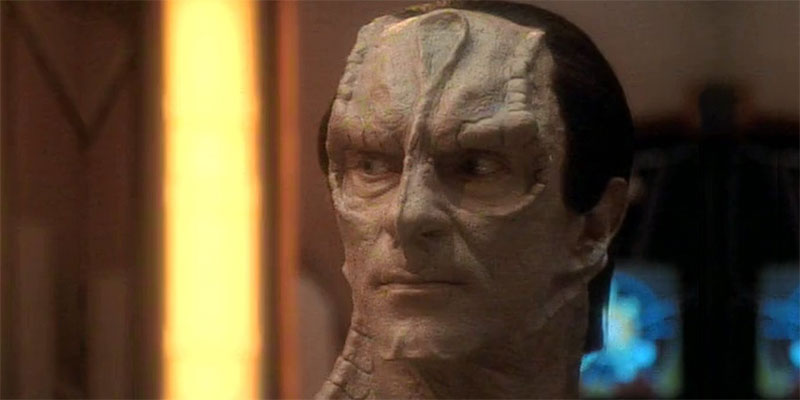
As a matter of fact, there really is no singular “last common ancestor” fossil that we have from the true parent of both mammals and reptiles. Most species who have lived throughout history don’t even leave fossils, and those who do can only give palaeontologists so much information—there’s a reason that it’s a science that has been constantly evolving (pardon the pun) for centuries. With this in mind, the closest Earth animals that I could feasibly come up with as a comparison to a hypothetical Cardassian ancestor are something like Biarmosuchia, early non-mammalian synapsids that had bony protrusions on their foreheads…sound familiar? These animals evolved from pelycosaurs, a group of so-called “mammal-like reptiles” formerly considered order in their own right but later reclassified. Pelycosaurs included the infamous Dimetrodon, a recognizable animal of the Permian period.
It’s unclear whether Cardassians’ evolutionary ancestors had full body hair at any point in their history or if their head hair is a more recent development. Whatever the case, it’s likely that Cardassians’ ancestors have always been some form of predator, with this and other “reptilian” traits as described by Westmore, Robinson, and others being passed down through generations and forming the basis of Cardassian physiology. And in addition, alongside these “reptilian” traits, Cardassians have clearly evolved to reproduce via placental viviparity, meaning they give live birth. Viviparity is a trait that is common in mammals but is also present in some non-mammalian animals, such as whale sharks.
So, what’s my verdict? Again, aside from the more accurate description that the Cardassians are just aliens with no direct analogue to the animal classifications we have on Earth, the best I can say is that they are, in fact, mammal-like reptiles. Hybrids of sorts, their ancestors would resemble some of the rather awkward-looking “middle stages” of evolution between the Permian reptiles who predated the dinosaurs and the hairy shrew-like beings who gave rise to the line that leads to us today. Life has a very interesting way, it seems, of developing into all kinds of veritable forms that are uniquely adapted to different environments—on Cardassia, it seems, these early synapsid-like predators won out.
I want to also quickly mention one other hypothesis regarding Cardassian evolution that would actually seem to turn everything we just went through on its head. The Cardassians’ relationship with the more human-looking Bajoran species may go deeper than just being an occupying force: some believe that the Cardassians and Bajorans may be the same species. What evidence is there for this theory? Well, Bajorans and Cardassians are two of the only known species in the galaxy who can reproduce naturally without medical intervention—even human-Vulcan hybrids require a lot of genetic manipulation to help them survive.
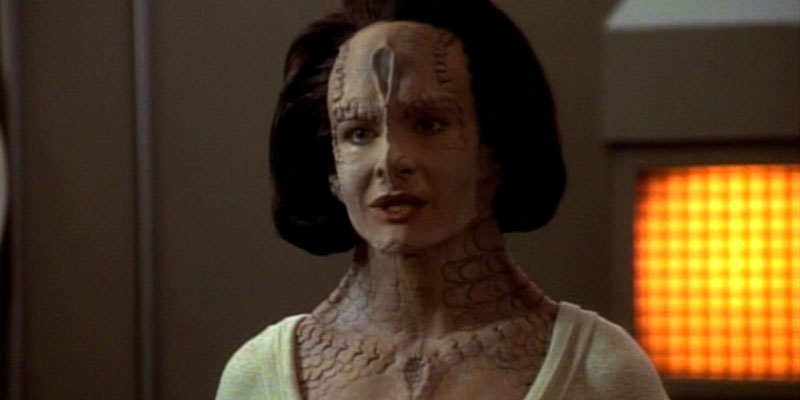
Furthermore, the Bajorans are known to have been capable of faster-than-light travel since the 16th century, predating the current phase of Cardassians’ expansion. A Bajoran solar sail vessel actually reached Cardassia—five light-years away—around this time, meaning first contact predated the occupation by over 700 years. Some have made a connection between the Bajorans and the Hebitian civilization, the first civilization to arise on Cardassia 10,000 years ago and whose artefacts are occasionally discovered in archaeological expeditions on the planet. The Hebitians were incredibly sophisticated, very spiritual and possessing solar technology themselves—just like the Bajorans. And according to the DS9 novel Avatar, artefacts made of jevonite—a rare mineral on Cardassia—were excavated on Bajor and proven via quantum dating to predate the Hebitians. At some point, after a major climate disaster, the Hebitians were wiped out by militaristic members of Cardassian society. What if the Hebitians were actually Bajoran colonists, and modern Cardassians might be Bajorans who genetically engineered themselves to be better adapted to Cardassia’s environment?
It’s a wild theory, one that has many holes. But the close biological connection between the Bajorans and the Cardassians is too uncanny to just leave unaddressed. I don’t personally subscribe to this theory just yet, as I feel more than just circumstantial evidence is necessary to make it more plausible, but it’s interesting nonetheless, and hey, maybe it could be true? It would be a nice twist regarding the power dynamics between the Cardassians and the Bajorans if the latter were always more powerful, to begin with, just as the Ba’ul were once the prey species on Kaminar before they enslaved the Kelpiens.
All in all, Cardassians clearly have an evolutionary history that is somewhat unique among other races heavily featured on screen in Star Trek. Not quite fully mammalian, not quite fully reptilian, resembling something in between—the Cardassians’ biology is really intriguing, and conducting research for this, particularly their resemblance to early therapsids, taught me a lot about evolution here on Earth.
Watch The Latest Video By Orange River Media Below
In the meantime, thanks for watching! I definitely want to hear your thoughts in the comments. If you enjoy content like this, becoming a patron HERE… It is a great way to support me.
Don’t forget to subscribe, and I’ll see you next time! Live long and prosper.
You can find Orange River Media at the links below
- YouTube: https://www.youtube.com/orangeriver
- Twitter: https://www.twitter.com/orangerivernw
- Instagram: https://www.instagram.com/orangeriver.nw
- Facebook: https://www.facebook.com/orangerivernw
- Patreon: https://www.patreon.com/orangeriver

